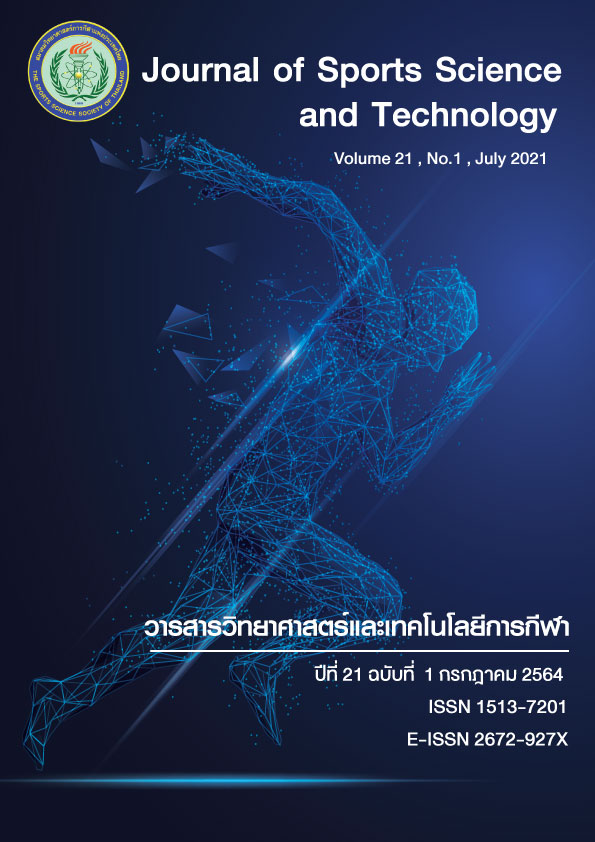The difference of HQ ratio and knee peak torque between the lower and higher mileage runners
DOI:
https://doi.org/10.14456/jsst.2021.6Keywords:
H:Q ratio, Runners, Muscular balance, Risk of knee injuryAbstract
Purpose: The purpose of this study was to determine the difference of H:Q ratio and peak torque between recreational runners with lower and higher mileage per week. Methods: Twenty-three healthy recreational runners (Male = 12 and female = 11) of physical therapy center running project age between 26 – 52 years (mean ± SD: 40.52 ± 8.38) were allocated to the “higher-mileage” group (> 32 km/week; n = 14) and to the “lower-mileage” group (< 25 km/week; n = 9) in 2018-2019. The performance of the knee muscles was tested by isokinetic dynamometer at angular velocity of 60, 120 and 180 degrees per second (º/s). The results of H:Q ratio and peak torque were analyzed with Independent-T Test and Mann-Whitney U to compare the data between the groups. Results: Runner group with higher-mileage demonstrated a higher H:Q ratio than the group with lower-mileage at all angular velocities. At an angular velocity of 180º/s, the group with higher-mileage showed significantly higher H:Q ratio than the group with lower-mileage (p <0.05). No significant difference of peak torque was observed between both groups. Conclusion: Running with a cumulative distance of > 32 km/week seems to approximate the normative quadriceps and hamstring muscle balance (The normal H:Q ratio is considered to be 60%). The H:Q ratio is likely to be normal in runner group with higher-mileage compared with the lower mileage group. When health professionals determine for running distance accumulation, the current findings could be used as a guidance in running rehabilitation.
(Journal of Sports Science and Technology 2021; 21(1):68-78)
(Received: 18 April 2021, Revised: 7 June 2021, Accepted: 7 June 2021)
KEYWORDS: H:Q ratio / Runners / Muscular balance / Risk of knee injury
*Corresponding author: Wannapong IMTANABUT
Biomechanics and Sports Research unit,
Faculty of Physical therapy, Mahidol University, Nakhon Pathom, Thailand 73170
E-mail: wannapong.imt@mahidol.ac.th
References
2. Upiriyasakul R, Bovonsunthonchai S, Sakunkaruna Y, Sakunkaruna S, Thong-on S, Laisirirungrai D. Incidence of Injuries in Marathon Runners; Bangkok Marathon. J Sport Sci Tech, 2015;15(1): 171-8.
3. Hespanhol Junior LC, Pillay JD, van Mechelen W, Verhagen E. Meta-Analyses of the Effects of Habitual Running on Indices of Health in Physically Inactive Adults. Sports Med. 2015;45(10):1455-68.
4. Boullosa D, Esteve-Lanao J, Casado A, Peyré-Tartaruga LA, Gomes da Rosa R, Del Coso J. Factors Affecting Training and Physical Performance in Recreational Endurance Runners. Sports (Basel). 2020;8(3):35.
5. van der Wall EE. Long-distance running: running for a long life? Neth Heart J. 2014;22(3):89-90.
6. van Gent RN, Siem D, van Middelkoop M, van Os AG, Bierma-Zeinstra SM, Koes BW. Incidence and determinants of lower extremity running injuries in long distance runners: a systematic review. Br J Sports Med. 2007;41(8):469-80.
7. World Health Organization. Country profile: Thailand. Noncommunicable diseases country profile 2018. 2018: 198.
8. Clermont CA, Phinyomark A, Osis ST, Ferber R. Classification of higher- and lower-mileage runners based on running kinematics. J Sport Health Sci. 2019 May;8(3):249-57.
9. Damsted C, Parner ET, Sørensen H, Malisoux L, Hulme A, Nielsen RØ. The Association Between Changes in Weekly Running Distance and Running-Related Injury: Preparing for a Half Marathon. J Orthop Sports Phys Ther. 2019 Apr;49(4):230-8.
10. Soligard T, Schwellnus M, Alonso JM, Bahr R, Clarsen B, Dijkstra HP, et al. How much is too much? (Part 1) International Olympic Committee consensus statement on load in sport and risk of injury. Br J Sports Med. 2016 Sep;50(17):1030-41.
11. Boyer KA, Silvernail JF, Hamill J. The role of running mileage on coordination patterns in running. J Appl Biomech. 2014;30:649–654.
12. Watari R, Kobsar D, Phinyomark A, Osis S, Ferber R. Determination of patellofemoral pain sub-groups and development of a method for predicting treatment outcome using running gait kinematics. Clin Biomech (Bristol, Avon). 2016;38:13-21.
13. Schmitz A, Pohl MB, Woods K, Noehren B. Variables during swing associated with decreased impact peak and loading rate in running. J Biomech. 2014;47:32–8
14. Wen D, Puffer J., Schmalzried T. Lower extremity alignment and risk of overuse injuries in runners. Med Sci Sport Exerc. 1997;29:1291–8.
15. Etiologic factors associated with patellofemoral pain in runners. Med Sci Sports Exerc. 1991;23:1008–15.
16. Ruas CV, Pinto RS, Haff GG, Lima CD, Pinto MD, Brown LE. Alternative methods of determining hamstrings-to-quadriceps ratios: a comprehensive review. Sports Med Open. 2019;5(1):11.
17. Drouin JM, Valovich-mcLeod TC, Shultz SJ, Gansneder BM, Perrin DH. Reliability and validity of the Biodex system 3 pro isokinetic dynamometer velocity, torque and position measurements. Eur J Appl Physiol. 2004;91(1):22-9.
18. Rosene JM, Fogarty TD, Mahaffey BL. Isokinetic hamstrings:quadriceps ratios in Intercollegiate Athletes. J Athl Train. 2001;36(4):378-83.
19. Struzik A, Pietraszewski B. Relationships between hamstrings-to-quadriceps ratio and variables describing countermovement and drop Jumps. Appl Bionics Biomech. 2019:4505481.
20. Sundby OH, Gorelick ML. Relationship between functional hamstring: quadriceps ratios and running economy in highly trained and recreational female runners. J Strength Cond Res. 2014;28(8):2214-27.
21. Düzgün I, Derya ÖZ, Baltaci G, Karacan S, Çolakoglu F. Improving the Hamstrings-to-Quadriceps Strength Ratio in Sedentary Women: Comparison of Stabilization Training and Aerobic Training After a 6-Months Follow-up. Clin Exp Health Sci. 2017; 7(2):45-51.
22. Sundby ØH, Gorelick ML. Relationship between functional hamstring: quadriceps ratios and running economy in highly trained and recreational female runners. J Strength Cond Res. 2014;28(8):2214-27.
23. Dellagrana RA, Diefenthaeler F, Carpes FP, Hernandez SG, de Campos W. Evidence for isokinetic knee torque asymmetries in male long distance‐trained runners. Int J Sports Phys Ther. 2015 (4):514.
24. Neophytou N, Charalambous T, Aginsky KD. Isokinetic hamstring and quadriceps muscle strength profiles of elite South African football players: sport science. Am J Health Educ. 2014;20(3):1225-36.
25. Horstmann T, Maschmann J, Mayer F, Heitkamp HC, Handel M, Dickhuth HH. The influence of age on isokinetic torque of the upper and lower leg musculature in sedentary men. Int J Sports Med. 1999;20(06):362-7.






